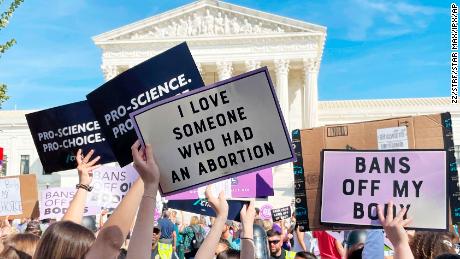The Department of Justice on Monday asked the court to halt a near-total ban on abortion in Texas. The justices’ prior action in a related case permitted the prohibition to take effect seven weeks ago in the country’s second more populous state.
The future of Roe v. Wade, the 1973 decision that made abortion legal nationwide, hangs in the balance. And the institutional stakes are equally significant. The conflict at this stage of the Texas litigation hinges on the role of the federal judiciary — including the high court nine — to vindicate constitutional rights.
“For half a century, this Court has held that a state may not prohibit any woman from making the ultimate decision to terminate her pregnancy before viability (when the fetus can live outside the womb),” Department of Justice lawyers said in their Monday filing, emphasizing that the Texas law “defies those precedents” by banning abortion before many women would even realize they were pregnant.
“The question now is whether Texas’s nullification of this Court’s precedents should be allowed to continue while the courts consider the United States’ suit,” DOJ added.
The Supreme Court gave Texas officials until noon Thursday to respond to the effort to block the law, which has been in effect since September 1 and has forced Texas women to travel to Oklahoma and other nearby states for abortions.
The justices on Monday also asked Texas officials to respond to the separate lawsuit from abortion clinics asking the high court to hear the merits of the litigation. Monday’s order expediting consideration of the clinics’ case, pending for several weeks, could be a sign that the justices are ready to deeply reevaluate abortion rights in America, perhaps expanding a Mississippi abortion dispute already pending this session. The Texas clinics have asked the justices to resolve whether the state can evade federal court review by delegating enforcement of the abortion ban to the general public.
However they decide to act in upcoming days, the integrity of the justices’ own institution is on the line. Their earlier action on September 1, spurning a plea by Texas clinics to block the law, unsettled the landscape of reproductive rights, as well as the justices’ image in the public eye.
A new test for the chief justice
The Department of Justice’s new and forceful plea for intervention offers Roberts another chance to persuade his colleagues to take a more deliberative approach to a subject that incites cultural, social and religious passions.
The justices already had scheduled oral arguments for December over a Mississippi law that forbids abortions after 15 weeks. The Texas law prevents an abortion if a fetal heartbeat is detected, which usually occurs around six weeks. The question in the Mississippi dispute is whether all bans on abortion before viability are unconstitutional.
The court’s September 1 decision fell along 5-4 ideologically charged lines. The majority’s one-paragraph order, issued at midnight, without the usual briefing or oral arguments, undermined nearly a half-century of privacy rights decisions and intensified scrutiny on their internal procedures.
A consistent line of cases, beginning with Roe v. Wade, have prevented government from forbidding abortion before fetal viability, estimated at about 22-24 weeks.
The justices in the majority on the Texas case declared that the clinics had failed to show women would be “irreparably injured” if the law were allowed to take effect. They emphasized that they were not deciding the overall merits of the case and acknowledged “serious questions regarding the constitutionality of the Texas law.”
In the majority were Justices Clarence Thomas and Samuel Alito, along with the three appointees of former President Donald Trump: Neil Gorsuch, Brett Kavanaugh and Amy Coney Barrett. Trump vowed to appoint justices who want to overturn Roe, and while none of the three has yet to cast an up-or-down vote on Roe, they each have disparaged the high court’s precedents through statements on or off the bench.
In dissent, Roberts, along with the three remaining liberals, had urged colleagues to put a hold on the “not only unusual, but unprecedented” law, cleverly written to shield it from judicial scrutiny.
The Texas statute empowers private citizens to sue anyone who assists a woman seeking to obtain an abortion and prevents state officials themselves from enforcing the ban, so they are shielded from liability.
“The desired consequence appears to be to insulate the State from responsibility for implementing and enforcing the regulatory regime,” Roberts wrote in his dissent. “I would grant preliminary relief to preserve the status quo ante — before the law went into effect — so that the courts may consider whether a state can avoid responsibility for its laws in such a manner.”
Liberal justices objected with more passion. “The Court’s order is stunning,” wrote Justice Sonia Sotomayor. “Presented with an application to enjoin a flagrantly unconstitutional law engineered to prohibit women from exercising their constitutional rights and evade judicial scrutiny, a majority of Justices have opted to bury their heads in the sand.”
Justice Elena Kagan noted that the justices had acted in the case “without full briefing or argument, and after less than 72 hours’ thought.”
She added that the majority’s action was “emblematic of too much of this Court’s shadow-docket decisionmaking — which every day becomes more unreasoned, inconsistent, and impossible to defend.”
The haste and lack of transparency related to the justices’ emergency procedures, dubbed the “shadow docket,” is one of the subjects being studied by President Joe Biden’s commission on the Supreme Court. That panel will not make formal recommendations for change, yet its overall attention on the court has added to the growing public scrutiny on its operations.
Gallup reported last month that the Supreme Court’s job approval rating dropped nine points since July, to 40% of Americans approving of the job the justices are doing. That poll was taken in early September, after the justices first let the Texas abortion ban go into effect. Other recent polls have shown that fewer than one-third of Americans want Roe v. Wade overturned.
DOJ argues federal supremacy
In the Department of Justice’s request on Monday, Acting US Solicitor General Brian Fletcher pointed up the distinct role of the federal government to protect rights, especially as Texas has thwarted “the mechanisms of judicial review long recognized by Congress and this Court.”
If the Texas law prevails, Fletcher warned, “a state could effectively nullify any constitutional decision of this Court,” including, he noted, to ban handguns in the home (contrary to Second Amendment rights under District of Columbia v. Heller) or prohibit corporate campaign advertising (contrary to First Amendment rights under Citizens United v. Federal Election Commission).
“Texas is not the first state to question Roe and Casey,” Fletcher wrote, referring to the 1973 landmark and the 1992 Planned Parenthood v. Casey decision that affirmed it. “But rather than forthrightly defending its law, Texas took matters into its own hands by crafting an ‘unprecedented’ structure to thwart judicial review.”
Texas state officials, scheduled to elaborate on their position by Thursday, argued in lower courts that the federal government lacks grounds to challenge the abortion ban. They stressed that the prohibition involves conduct between private parties and maintained the government cannot sue states to vindicate individual abortion rights under the Fourteenth Amendment.
A US district court judge in Texas ruled for the Department of Justice earlier this month, producing a 113-page opinion that declared Texas had pursued an “aggressive scheme to deprive its citizens of a significant and well-established constitutional right. From the moment (the law) went into effect, women have been unlawfully prevented from exercising control over their lives in ways that are protected by the Constitution. That other courts may find a way to avoid this conclusion is theirs to decide; this Court will not sanction one more day of this offensive deprivation of such an important right.”
A federal appellate court reversed the effect of that order and reinstated the law. The 5th US Circuit Court of Appeals declined in an October 14 order to address the merits of the DOJ position, citing its prior court action against the Texas abortion clinics.
Now, as the Supreme Court weighs the newest plea to intervene, in US v. Texas, the justices may agree to block the abortion prohibition until the merits of a challenge can be heard. Or the court may let the ban remain in place, intensifying the firestorm and again rewarding Texas for a legal framework intended to avoid the scrutiny of judges.
Either way, the justices’ action in upcoming days is likely to represent a prelude to the justices’ ultimate resolution of Roe v. Wade’s fate, which their recent moves have thrown in doubt.









